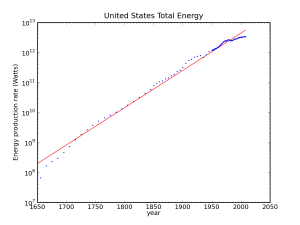This post originally appeared on the Carbon Talks blog.
Economics is a brittle science. Indeed I’m wading into a debate by calling it a science at all, but despite being able to modestly predict and forecast markets, economics has a history of spectacular failure. As human creations that do not exist outside of our own collective consciousness, anybody who would claim to have built a model for infinite, or at least sustained and long-term economic growth, is simply – and I say this with honest respect for the great economists – guessing. The physical sciences, on the other hand, are built upon testable hypotheses and repeatable experiments. Over the centuries we have developed laws and theories that we can use to accurately, if not always precisely, predict outcomes.
So when we marry these disciplines together, there is an inherent conflict. In the realm of energy and fuel production, economics and the physical sciences – such as biochemistry, geophysics, or meteorology – trade off between cooperation and hostility. Cooperation when science gives economics what it needs for continued growth, and hostility when the opposite is true.

In a 2011 post that quickly became an internet classic, UC Professor Tom Murphy described the impossibility of the continued growth of energy consumption. In his post, titled “Galactic-Scale Energy”, Murphy uses intentionally absurdist arguments to show how our current trajectory of energy use is completely untenable. He says that given a 2% annual increase in energy consumption (a reasonable estimate given historical trends) we will need to cover all the land on Earth in solar panels by 2385. That leaves no room for cities, forests, roads, farmland, or open pit mines; literally every square meter of land would be devoted to collecting energy.
Murphy is the first to admit that his predictions are cautionary, rather that realistic. We should take comfort in the assumption that world population growth will slow and plateau. Combined with the assumption of increased energy efficiency, and surely we will be in the position to meet energy demands without covering every last plot of land in solar panels. But how valid is that assumption?
If our current efforts are any indication, there is cause for concern. This week, corporate mega-giant Walmart released its 2012 global responsibility report titled “Beyond 50 years: Building a sustainable future”. Being the world’s largest retailer brings with it a certain degree of responsibility, and to be fair, Walmart is doing its part. Since 2011, among other listed accomplishments, the company has claimed to have reduced waste by 80%, turned almost entirely to locally grown produce, and moved to LED lighting. Thanks to these efforts, their GHG emissions per dollar of sales are declining steadily. Unfortunately that’s a combination of economic and physical measurements, and the result is misleading; total GHG emissions are actually rising by some 0.5 million tonnes of C02 per year (reaching 22 million tonnes total for 2010).
Charting emissions per dollar of sales is a nice metric for showing increased efficiency, but it’s not unlike countries such as China that prefer to measure their emissions reductions in terms of emissions intensity. While such numbers can describe relative increases in economic efficiency, they completely mask the reality of overall increased energy usage.
We are using more, and there are more of us. When my parents were born, there were 2.5 billion people on Earth; we’ve now passed 7 billion. Many of those billions are now driving cars, using phones, demanding imported goods, and buying into a consumerist lifestyle that encourages obsolescence and replacement. The Walmart example shows us that despite commendable and impressive efforts to increase efficiency, energy consumption will continue to increase if we do not change our habits.
While economists can happily predict a higher standard of living for everyone, with sustained and measured economic growth, they can’t break the laws of physics. There is a limited amount of energy in play, and we are using too much of it. Home retrofits, increased reliance on public transportation, high-density living, local food movements: these are areas where we can save energy. It is only a combination of investment in such innovative technologies and systems with a serious and dramatic cultural paradigm shift, that will allow us to prove the economists right.
(Feature photo courtesy of Daquella manera/Flickr, graph courtesy Professor Tom Murphy)

